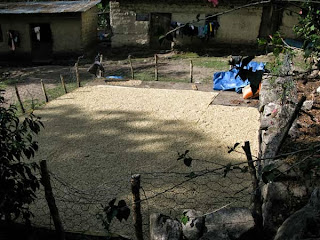The habitat was more lush and jungly the farther down in elevation we went.
The walking was easy: the trail kept heading down and down, but not at too great an incline to be particularly hard on the knees.
Most of the day was spent following the river that you see in the photo. Our guides stated that if we kept following it, we could paddle down the Amazon and meet the Atlantic Ocean.
I continued to be fascinated by the people living along the river. You would see houses or a collection of very small buildings and gardens clinging precariously on the side of the mountain - which was very steep if you got off the trail. I can't imagine farming the plots, much less transporting what you grow to sell to someone.
You can just see a bridge across the river in this photo - and there weren't many bridges.
Every once in a while, we would traverse a drainage coming straight down the mountainside. I can't imagine what it was like in the rainy season but I doubt that the trail is passable across these drainages.
There were many flowers: begonias, orchids, and many many more.
I just took this photo to show what much of the trail was like: a pass through the vegetation with occasional drops to the river that allowed us to see up and down the valley.
You can never forget lunch! This is our lunch spot. Lunches always had a hot dish and three courses: appetizer, main, and dessert. Peruvians typically have their main meal in the middle of the day.
An interesting sidelight is that our cook and cook's helper, Rosita and Paulina, traveled along the same route and cooked all our meals. We would leave in the morning and pretty soon they would come walking through - about twice the speed that we were walking. They would cook and serve lunch and then walk to the next lodge and cook and serve dinner. We would also see our "pack train" of maybe 4-6 horses or burros packing the food for the lodge part of the trip and our "night" gear. We only had to haul our day pack. Nice.
At the lunch spot, there was a tram across the river over to the other side.
Bob and Glenda were fearless and rode it out to the middle and back. There was a rope on each end of the tram connected to each side of the valley. You just hauled on the rope in the direction you wanted to go.
ML was game, but I was chicken! There are some heights I don't like and that was one of them!
Some of you shoppers out there might want to run back to the "Rest Place Shopping Center." I think you might find some bargains. I couldn't tell you how to get there, it was just a wide spot on the trail.
Be careful to call ahead and see what hours they're open.
ML declined to shop, but she's not much of a shopper anyway.
REI/Mountain Lodges, in their infinite wisdom, had a van waiting at the 9.5 mile mark to spare us 6 more miles along a road and one of the biggest towns in the area. I think most of us were glad to see the van. We said good-bye to Primo, Motor, and Rambo (don't forget the Spanish accent) and the rest of the gauchos who transported all our gear for the last 4 days. Glenda had some nice trinkets to give them like "Devil's Club" salve from Southeast Alaska. I think they really appreciated her, and us by association(!), giving them something in appreciation for their work.
The van dropped us off at one of the more classic "Inca" trails. There are Inca trails all over the place! This one lead up to 3 or 4 Inca ruins - but fortunately the Lucma Lodge was not very far up the trail.
Along the way we saw coffee farms and avocado orchards. There was a much greater concentration of small farms near the road where the trail departed from. These coffee beans were drying in the sun after the berry part had been stripped from the bean.

We arrived at the lodge for our daily cool cloths and drinks. After a short break, we had the option to go see a coffee farm - which we all opted for.
First, a walk through the coffee trees. We were there toward the end of the season.

After a demonstration of the machine that strips the berry part from the bean, we piled into this woman's kitchen to see how the beans were roasted. This is her kitchen and eating place. I imagine it is partly built for the gringos, but it felt authentic.
Here the woman and her husband roast the beans in a cast iron pan that fits over a hole in an adobe type of fireplace. As you can see, the fire is fed from the front. She roasted the beans from their farm and then ground them by hand and we all got a demitasse of coffee. It was great!
Part of the authenticity was the gaggle of guinea pigs wandering around under our feet looking for a bite to eat.
But it was time to eat our own dinner. I shouldn't have been hungry after that lunch, but I was. I just hoped it wasn't guinea pig.










No comments:
Post a Comment